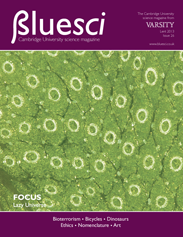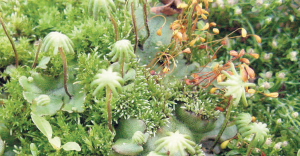FRIDAY, 25 JANUARY 2013
Shown in the image are the repeating air pore structures from the leaves of Marchantia polymorpha, a species of liverwort. The repeating air pores which are composed of only a few dozen cells, make an interesting study of cell morphology (structure), but it is not these which may bring this common weed into the limelight in the near future. Despite being a nuisance to horticulturalists everywhere, this lower plant has the potential to become the next chassis for an exciting new field: synthetic biology (SynBio).Synthetic Biologists apply common engineering principles such as standardisation to biology. Although these principles have been used to great effect in more traditional disciplines such as structural or mechanical engineering (where the standardisation of parts like the bolt spurred on the industrial revolution), they have not been applied to biological systems in the past. Indeed, had the name not already been taken, SynBio might well have been called genetic engineering. While the two fields sound similar, their entire philosophy is radically different. English comedian Simon Munnery effectively summed up the distinction by saying that “genetic engineering isn’t really engineering at all. The engineering equivalent would be to throw a load of steel and a load of concrete into a river and if someone managed to walk over it, calling it a bridge”. Genetic engineering uses genes in new contexts, but makes no attempt to understand the underlying scientific principles. In genetic engineering you throw everything you can at the problem and see what sticks.
In SynBio, engineers find and characterise interesting and useful biological functions from a wide range of organisms such as the bioluminescence of the firefly or the arsenic detection systems found in many bacteria. With these parts, new ‘programs’ can be written in DNA code to perform novel functions.
An important example is the production of artemisinic acid, a chemical precursor to artemisinin — the most effective antimalarial available. Although Atemisinin Combination Therapies (ACTs) are highly effective, malaria is still a major killer, with between 2000 and 3000 people dying of the disease each day in 2010. Part of the reason why ACTs have not yet proved fully effective is that artemisinin is rather hard to come by. It is found naturally in sweet wormwood (Artemisia annua) and can be extracted directly from the plant or synthesised chemically, but both methods are rather time-consuming, expensive and unscalable.
In 2006, a team of synthetic biologists successfully introduced the metabolic pathway responsible for biosynthesis of artemisinic acid into yeast, a faster growing and easier to harvest organism. When the resulting drug becomes available next year, it will be produced on an industrial scale not unlike the brewing process at a cost per treatment of only $0.25.
So how does our cover come into this? Plants have a natural advantage over yeast: yield. When deciding how much energy to put into the artemisinic acid pathway, a delicate balance had to be struck. Too much and the added effort would inhibit growth of the cells, too little and there wouldn’t be enough artemisinin produced to make the process worthwhile.
It is hoped that by using plant chloroplasts as a host this will become less of a problem. Chloroplasts are organelles (simpler compartments within a cell) which perform photosynthesis and produce large amounts of energy for the cell from sunlight. But despite their comparative simplicity, chloroplasts are clearly well suited to producing large amounts of things; for example the enzyme RuBisCo is probably the most common protein on earth and found in chloroplasts. Each cell can contain hundreds of chloroplasts, each one containing up to a thousand copies of the chloroplasts genome. In this way it would be able to have several thousand copies of the artemisinic acid pathway in a single cell, each one being directly powered by photosynthesis.
Exploiting this natural ability would be of key importance to projects like the Artemisinin Project and could make mass producing important biological substances significantly cheaper than current methods.
Haydn King is a 4th year undergradutate in the Department of Engineering


